Size: 500 pieces
Dimensions: 45.5 cm x 27 cm
Producer: Encore!
Puzzle:
Notes:
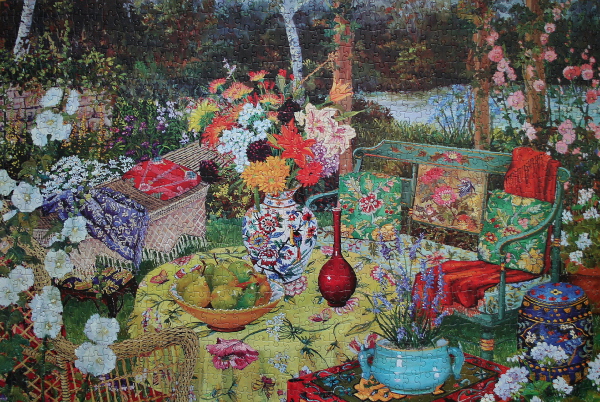
Size: 1000 pieces
Dimensions: 73 cm x 48.57 cm
Artist: John Powell has worked in the arts through out his life. Born in Hollywood, California, he began to paint at the age of 16. Over the past 35 years he has melded his life experiences into a signature style of painting. His paintings are precise and intricate, laced with lyrical realism and expressing his love for color, flowers, gardens, pottery and art from around the world, interesting fabrics and visions of his travels.
Painting: original
Producer: The Canadian Group, Sure-Lox, 2013, #44724-1
Puzzle: Beautifully-complex puzzle with many colourful regions. There are many ways to approach it: some of the easier parts to assemble first are the turquoise flower pot, the blue box in the bottom right, the red cloth draped over the bench, the checkered rose tablecloth, the pears and their bowl, the large and smaller red vases, the yellow flowered tablecloth, the bottom left corner, the flowers in the vases, and the river in the background. There are many other smaller distinct regions that can then be positioned in place.
Size: 750 pieces
Dimensions: 46 cm x 60 cm
Producer: unknown
Notes: I’m missing the box for this puzzle and am unable to find the real name of it or the producer. If you have that information, could you please let me know?
Puzzle: An easy puzzle to do with pieces fitting well together. Distinct colour ranges on the yellow drawing, the rose curtain, the pillars, the blue of the window, the vertical guides of the candle and the books, as well as the horizontal guide of the table edge, split this puzzle into easy-to-manage regions. The pieces are large and the colours distinct enough to enjoy even in suboptimal lighting.
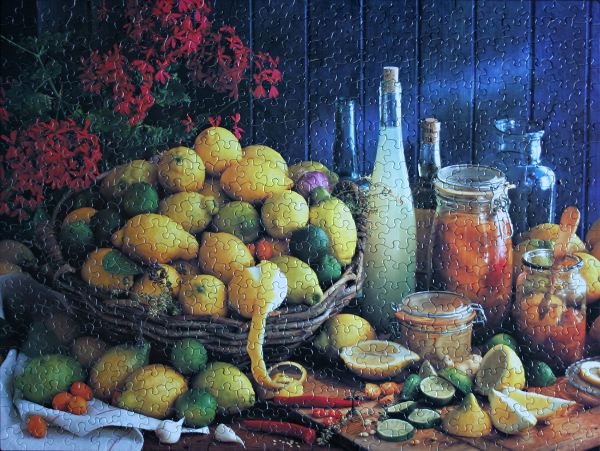
Size: 550 pieces
Dimensions: 61 cm x 46 cm
Producer: Ceaco, Culinary Classics series, 1999, #2319-6
Notes: A lovely and zen puzzle to assemble. There are many ways to approach it: I have started with the tallest bottle and the tall jar with orange contents, followed by the red flowers and the blue fence in the background. The red peppers, white towel and garlic, the basket, and cut up lemons and limes followed. The fruit in the basket and under it came after, and the rest of the pieces came together easily then.
Size: 500 pieces
Dimensions: 48.5 cm x 35.5 cm
Producer: Sure-Lox, The Canadian Group, Mother’s Cupboard series
Puzzle: Some days I like nature mort compositions. This one is not completely trivial, since there are so many white areas and most cups look similar, but it is small enough for that not to present too much challenge. The shelf is the easiest place to start, as it separates the puzzle into two areas providing a good horizontal guide. The distinct colour areas such as lavender and blue cups, as well as the round edges and patterns on the plates are easy to assemble, as well as the glasses on the bottom shelf. The wall pattern and the rest of the cups can follow.
Size: 1000 pieces
Dimensions: 51 cm x 69 cm
Artist: John O’Brien
Producer: Empire, Puzzle Makers, Rooms with a View collection, #64020-001
Puzzle: Beautiful puzzle, gentle colours, the pieces fit together well. The repetition of the window parts makes for a bit of a challenge to assemble the largely-similar window grids, but there is enough variation in the room furnishings bordering the backdrop to make the assembly enjoyable. I have started with the window tops and continued with windows themselves, although it might be easier to first focus on the armchairs and sofa, corner tables, plants, the rug and the floor. Either way the large sections separating the windows provide good vertical guides whereas the rug pattern and the rug/floor border make for horizontal guides that can direct the assembly.
Size: 1000 pieces
Dimensions: 51 cm x 69 cm
Artist: John O’Brien
Producer: Empire, Puzzle Makers, Rooms with a View collection, #64020-001
Puzzle: This puzzle is a pleasure for the eye. Lots of vibrant colours and small details. The pieces fit together well. The easiest regions to start are the vertical guides of the balcony doors and the white tall window, the street with the sky and buildings, the paintings and their frames, the dark red border decoration at the top of the walls, and the green of the walls themselves. The cupboard, the chairs and love seat, and the fireplace can come next, with the rug pattern to follow. The rest of the small details can then be filled in.
Size: 1000 pieces
Dimensions: 51 cm x 69 cm
Artist: John O’Brien
Producer: Empire, Puzzle Makers, Rooms with a View collection, #64020-001
Puzzle: Leisurely puzzle to make, with pieces fitting together reasonably well. Many possible places to start: vertical guidelines of the gold embellishments on the white walls, the opening into the street with buildings and draperies, the border of the floor and the rug, the red regions of the furniture and the darker regions of the paintings, the fireplace, and the side tables with flower vases. The harp and the piano, the furniture pieces, and the rug can then follow, and the rest is relatively simple. Lots of little details, visually a very rich puzzle for the eyes.
Notes: A concert hall is a place where concerts of classical music take place. [Wiki]
Size: 1000 pieces
Dimensions: 49 cm x 68 cm
Artist: possibly Abraham Hendriksz van Beyeren (unsure, since puzzle box does not list the artist)
Producer: Jumbo International, #00023
Puzzle: A very rich puzzle in terms of colours and arrangement. One of the ways to approach it is to start with the larger areas of similar colour: red flowers, yellow ones, large pink and striped ones. After that, the vase and the table, as well as larger green leaves, blue stand-alone flowers, the butterfly, and the pastel flowers can be tackled. The pillar in the left top quarter separates the top area into three distinct regions and can be used as a vertical guide. The rest of the arrangement fills out easily from there. Overall, a very enjoyable vibrant puzzle, made with good quality paper.
Notes: Floral design or floral arts is the art of creating flower arrangements in vases, bowls, baskets or other containers, or making bouquets and compositions from cut flowers, foliages, herbs, ornamental grasses and other plant materials. Often the terms “floral design” and “floristry” are considered synonymous. Florists are people who work with flowers and plants, generally at the retail level. Floristry differs from floristics, the study of distribution and relationships of plant species over geographic areas. Floristry also differs from horticulture, which more broadly relates to the cultivation of flowers and plants so they will remain fresh as long as possible, and would be desirable for purchase, which also involves knowledge of customers’ requirements and expectations. The ability to create a variety of floral designs such as wreaths, bouquets, corsages, boutonnières/’buttonholes’, permanent arrangements and other more complicated arrangements is also important. [Wiki]
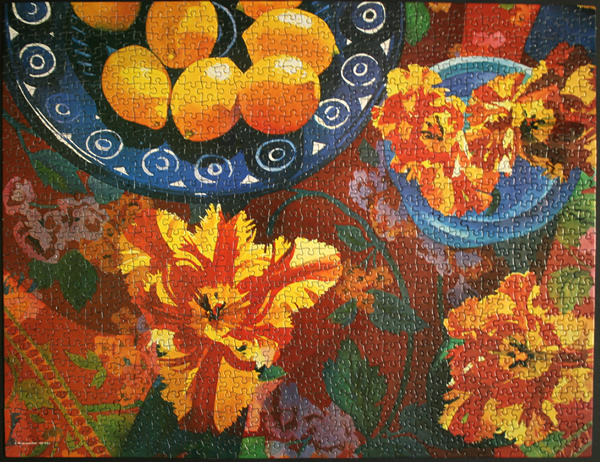
Size: 1000 pieces
Dimensions: 51.12cm x 66.52cm
Producer: Hasbro, MB Puzzles, Big Ben, Artist Series, Nava Grunfeld, 2008
Puzzle: This puzzle is not trivial, but not significantly difficult either. Large blue dish with white spirals and smaller blue dish give a good outline to the top half of the puzzle. Lemons can be filled in afterwards, as well as the lilac-coloured flowers. From that point on, green, yellow, orange, red, and brown patches are equally challenging: I ended up finishing with the tulips, but perhaps a reversal might have been easier.
Artist: Artist Nava Grunfeld was born in Sweden and grew up in Israel, where she began to closely observe nature. She is known for her bold watercolor paintings of still life objects, fruit and flowers. Her technique of layering multiple veils of transparent color onto each painting brings a luminous quality to her work. Like a stained glass window, the white of the paper acts as the light source that glows through the colors. [Puzzle box]
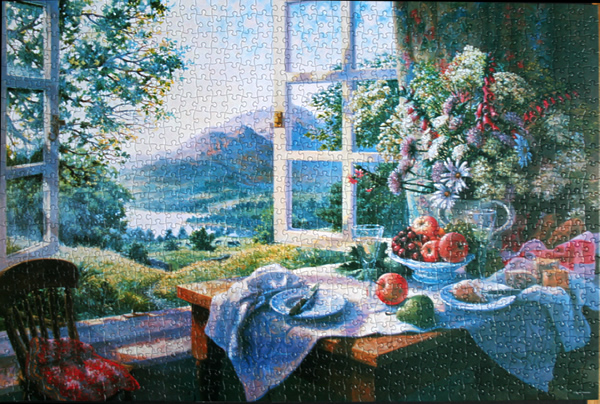
Size: 1000 pieces
Dimensions: 73cm x 48.57cm
Producer: Sure-Lox, The Canadian Group, Canvas Collection series, 2011, #44716-1
Artist: Stephen Darbishire/Rosenstiel
Puzzle: There are multiple regions of the puzzle that can be done independently: fruit, cheeses, yellow/green grass, blue cloudy patch of sky, wooden table parts, bottom of the window, and the chair cushion. From that point on, the window frame, the bright tablecloth top and plates, the lilac of the mountains, and the dark blue/purple of the tablecloth can be completed. The tree branches, the white of the sky, the remaining bouquet, and the dark curtain and bottom left corner remain. Very pleasant and calming puzzle to do, due to a variety of patterns, vivid colours, and serene imagery.
Wild flower: A wild flower is a flower that grows in the wild, meaning it was not intentionally seeded or planted. The term implies that the plant probably is neither a hybrid nor a selected cultivar that is in any way different from the way it appears in the wild as a native plant, even if it is growing where it would not naturally.
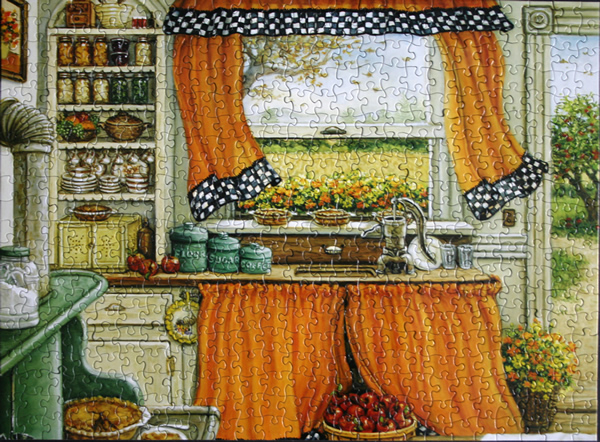
Size: 500 pieces
Dimensions: 45.26cm x 35.56cm
Producer: Sure-Lox, The Canadian Group, Country Kitchen series, 2011, #42225-3
Artist: Janet Kruskamp
Puzzle: The orange curtains and the checkered parts are an easy place to start. Flowers on the window sill, apples, edge of the green table, sky, and tree can follow. The pipe, door frame, garden, and beige cupboard can be finished next, leaving the cans, dishes, and a few other small areas to complete. Very pleasant and staightforward puzzle. It also includes a shortbread cookies recipe and a red puzzle piece cookie cutter.
Baking: In ancient history, the first evidence of baking occurred when humans took wild grass grains, soaked them in water, and mixed everything together, mashing it into a kind of broth-like paste. The paste was cooked by pouring it onto a flat, hot rock, resulting in a bread-like substance. Later, this paste was roasted on hot embers, which made bread-making easier, as it could now be made anytime fire was created.
In ancient history, the first evidence of baking occurred when humans took wild grass grains, soaked them in water, and mixed everything together, mashing it into a kind of broth-like paste. The paste was cooked by pouring it onto a flat, hot rock, resulting in a bread-like substance. Later, this paste was roasted on hot embers, which made bread-making easier, as it could now be made anytime fire was created. [Wiki]
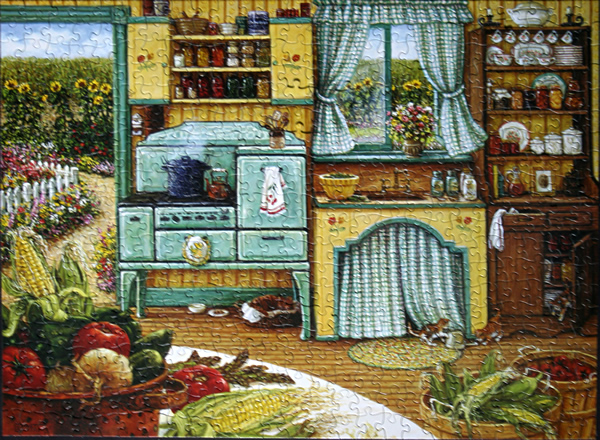
Size: 500 pieces
Dimensions: 45.26cm x 35.56cm
Producer: Sure-Lox, The Canadian Group, Country Kitchen series, 2011, #42225-2
Artist: Janet Kruskamp
Puzzle: A logical starting point are the checkered curtains, followed by the yellow batches of colour and the stove. Floor boards, white table, garden path and flowers, the patches of sky, and the vegetables make stand-alone regions that are easy to put together. Door frame and window frame logically fall into place. The rug, corn, and places under the stove follow, to leave only the cupboards and a few dark areas. Easy and fast puzzle to do. It also includes a shortbread cookies recipe and a red puzzle piece cookie cutter.
Canning: Canning is a method of preserving food in which the food contents are processed and sealed in an airtight container. Canning provides a typical shelf life ranging from one to five years, although under specific circumstances a freeze-dried canned product, such as canned, dried lentils, can last as long as 30 years in an edible state. In 1795 the French military offered a cash prize of 12,000 francs for a new method to preserve food. Nicolas Appert suggested canning and the process was first proven in 1806 in test with the French navy and the prize awarded in 1809 or 1810. The packaging prevents microorganisms from entering and proliferating inside.
To prevent the food from being spoiled before and during containment, a number of methods are used: pasteurisation, boiling (and other applications of high temperature over a period of time), refrigeration, freezing, drying, vacuum treatment, antimicrobial agents that are natural to the recipe of the foods being preserved, a sufficient dose of ionizing radiation, submersion in a strong saline solution, acid, base, osmotically extreme (for example very sugary) or other microbially-challenging environments. [Wiki]
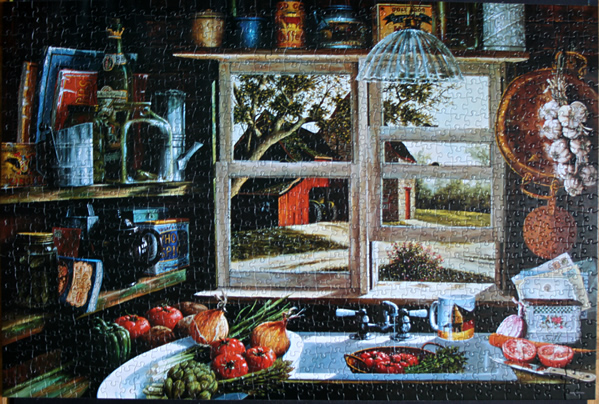
Size: 1000 pieces
Dimensions: 73cm x 48.57cm
Producer: Sure-Lox, The Canadian Group, Canvas Collection series, 2011, #44716-5
Artist: H. Hargrove
Puzzle: A rather detailed puzzle with many small regions of colour. White sink and plate, garlic and the orange objects behind it are probably the easiest place to start. The metal watering can, the light fixture, and the dark yellow/orange on the top shelf and the book in the lower left are several groups of colour that are easy to do. The tree and the red of the shed outside, followed by the window sill, leaves mostly dark regions to complete the puzzle. I found it quite an engaging one.
Asparagus: Asparagus has been used as a vegetable and medicine, owing to its delicate flavour, diuretic properties, and more. It is pictured as an offering on an Egyptian frieze dating to 3000 BC. Still in ancient times, it was known in Syria and in Spain. Greeks and Romans ate it fresh when in season and dried the vegetable for use in winter; Romans would even freeze it high in the Alps, for the Feast of Epicurus. Emperor Augustus reserved the “Asparagus Fleet” for hauling the vegetable, and coined the expression “faster than cooking asparagus” for quick action. A recipe for cooking asparagus in the oldest surviving book of recipes, Apicius’s third-century AD De re coquinaria, Book III. [Wiki]
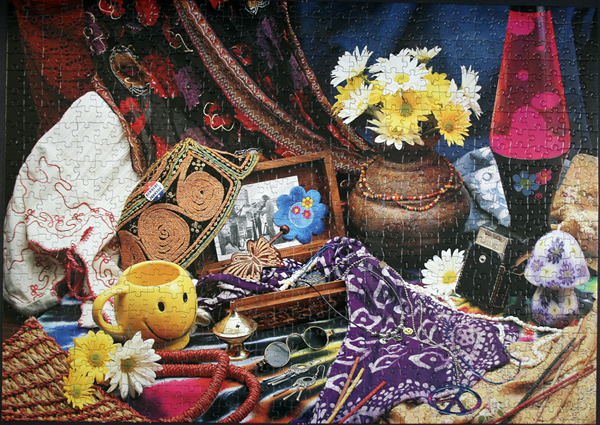
Size: 750 pieces
Dimensions: 48.1cm x 68cm
Producer: Kodak, RoseArt, Decades series, No.21020
Puzzle: Enough different colours and textures to make the completion of this puzzle a breeze. Yellow cup and flowers, purple and white fabric, lava lamp, white fabric with red embroidery, the photograph, the straw hat are all sufficiently different to be easily assembled first, guiding the rest of the puzzle to completion.
The 60’s: The counterculture movement dominated the second half of the 1960s, its most famous moments being the Summer of Love in San Francisco in 1967, and the Woodstock Festival in upstate New York in 1969. Psychedelic drugs, especially LSD, were widely used medicinally, spiritually and recreationally throughout the late 1960s, and were popularized by Timothy Leary with his slogan “Turn on, tune in, drop out”. There was a growing interest in Eastern religions and philosophy, and many attempts were made to found communes, which varied from supporting free love to religious puritanism. [Wiki]
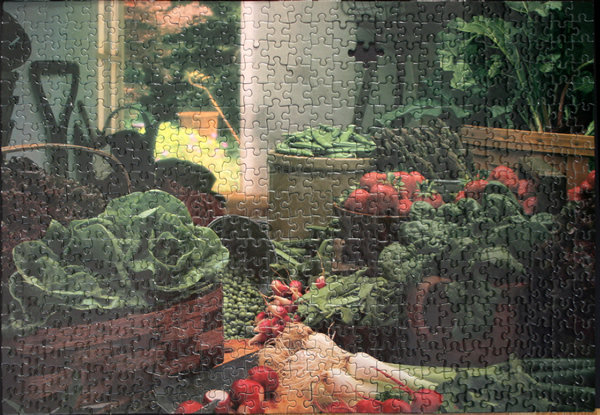
Size: 500 pieces, 1 missing
Dimensions: 35.24cm x 50.48cm
Producer: MB Puzzle, Croxley series, 1997, #4611-22
Puzzle: Pleasant puzzle, preferably done with good lighting. Lots of green, grey, and brown, but easy enough to assemble. Several bright regions (strawberries, onions, window, and walls) as well as the horizontal and vertical surfaces lay a good foundation to guide the completion of the puzzle.
Produce: Produce is a generalized term for a group of farm-produced crops and goods, and is not limited to fruits and vegetables (i.e. meats, grains, oats, etc. are sometimes considered as produce.) More specifically, the term “produce” often implies that the products are fresh and generally in the same state as where they were harvested. Produce is the main product sold by greengrocers, farmers’ markets, and fruit markets. [Wiki]
Size: 500+ pieces
Dimensions: 89.5cm x 71.5cm
Producer: Battle Road Press
Artist: Jan Van Os, Dutch (1744-1808)
Painting: Oil on canvas, Gift of Mrs. John Harris Clay, 92.13, The J.B. Speed Art Museum, Louisville, Kentucky, ISBN 0-934967-76-8
Notes: Jan Van Os was born in the small Dutch town of Middleharnis in 1744, but spent most of his life in The Hague, Holland, where he studied with the painter Aart Schoumann. Although Van Os occasionally painted marine subjects, he built his reputation on still-life paintings like the one in the Speed’s collection. He frequently exhibited at the Society of Artists in England and sold many of his paintings to members of the English and French aristocracy. Scholars today credit Van Os with perpetuating the Dutch flower-painting tradition and the style of the leading still-life artist, Jan van Huysum (1682-1749), into the late eighteenth and early nineteenth centuries.
Still Life with Fruit and Flowers is characteristic of Van Os’s large, abundant still-lifes. In it, he depicted a variety of colorful and occasionally exotic plants and fruits in a sculpted terra-cotta vase placed on a marble ledge. Van Os employed two different techniques to render the textures of the various objects. He applied wet paint on a web underlayer and blended the colors to create the subtle variations in tone in the landscape. For the fruit, insects and water drops, however, Van Os painted over a dry underlayer to depict their crisp edges and details.
Like many Dutch artists, Van Os relied on traditional metaphors or symbols to convey meaning in his paintings. In Still Life with Flowers, Van Os contrasted images which suggested the sinful, material world with objects related to the spiritual realm of God. The cat, for example, was often associated with witches, and therefore was commonly thought of as evil or lustful. The mouse was considered an earthbound animal that relied on the material world for survival. Shown eating, as it is here, the mouse also symbolized gluttony. Other objects in the painting that allude to sin are the peaches, emblems of physical pleasure, and the melon, once thought of as a luxurious unhealthy fruit. In contrast to these negative images are objects which serve as reminders of God. The butterfly and dragonfly, for example, symbolize the resurrected soul. The three-part shape of the iris is like the three-part nature of the Trinity. The grapes and the small red currants refer to the wine of the Eucharist or Communion, and thereby symbolize the blood of Christ.
Van Os’s detailed studies of fruit and flowers in lush landscape settings made his paintings immensely popular among collectors during his lifetime, as well as among museums and collectors today.
The J.B. Art Speed Museum was founded by Hattie Bishop Speed as a memorial to her husband, James Breckinridge Speed. Since opening its doors in 1927, the J.B. Speed Art Museum has become Kentucky’s largest and most comprehensive public art collection with works by such masters as Rembrandt, Rubens, Tiepolo, Monet and Picsasso. The Museum’s permanent collection consists of over 8,000 works of art spanning 6,000 years of history from Antiquity to the present day. [Puzzle box]
Size: 500 pieces
Dimensions: 40.64cm x 40.64cm
Producer: Hasbro, MB Puzzle, Big Ben series
Notes: Syringa (Lilac) is a genus of about 20–25 species of flowering woody plants in the olive family (Oleaceae), native to woodland and scrub from southeastern Europe to eastern Asia, and widely and commonly cultivated in temperate areas elsewhere.
The usual flower colour is a shade of purple (often a light purple or lilac), but white, pale yellow and pink, and even a dark burgundy color are also found. The flowers grow in large panicles, and in several species have a strong fragrance. Flowering varies between mid spring to early summer, depending on the species. The fruit is a dry, brown capsule, splitting in two at maturity to release the two winged seeds.
Lilacs are popular shrubs in parks and gardens throughout the temperate zone. In addition to the species listed above, several hybrids and numerous cultivars have been developed. The term French lilac is often used to refer to modern double-flowered cultivars, thanks to the work of prolific breeder Victor Lemoine. Lilacs will grow in a wide variety of soil types and prefer neutral to slightly acidic soil. [Wiki]
Size: 1000 pieces
Notes: I do not have a record of the dimensions or the producer of this puzzle as I do not have the box anymore. A clarification is welcome – if you have any clue as to the details regarding this puzzle, I would much appreciate that information.
The pear is any of several tree species of genus Pyrus and also the name of the pomaceous fruit of these trees. Several species of pear are valued by humans for their edible fruit, but the fruit of other species is small, hard, and astringent.
The genus Pyrus is classified in subtribe Pyrinae within tribe Pyreae. The apple (Malus domestica), which it resembles in floral structure, is also a member of this subcategory.
Pears grow in the sublime orchard of Alcinous, in Odyssey vii: “Therein grow trees, tall and luxuriant, pears and pomegranates and apple-trees with their bright fruit, and sweet figs, and luxuriant olives. Of these the fruit perishes not nor fails in winter or in summer, but lasts throughout the year.”
The pear was also cultivated by the Romans, who did not eat them raw: Pliny’s Natural History recommended stewing them with honey and noted three dozen varieties. The Roman cookbook attributed to Apicius, De re coquinaria, has a recipe for a spiced, stewed-pear patina, or soufflé. [Wiki]
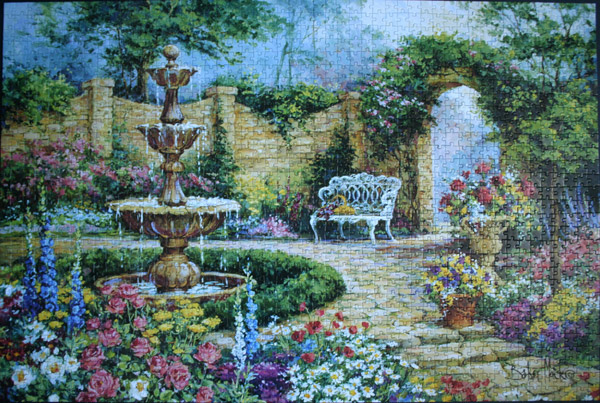
Size: 1500 pieces Dimensions: 60cm x 90cm Producer: Jumbo International, Amsterdam, #00681 Artist: Barbara Mock Notes: A fountain (from the Latin “fons” or “fontis”, a source or spring) is a piece of architecture which pours water into a basin or jets it into the air either to supply drinking water or for decorative or dramatic effect. Fountains were originally purely functional, connected to springs or aqueducts and used to provide drinking water and water for bathing and washing to the residents of cities, towns and villages. Until the late 19th century most fountains operated by gravity, and needed a source of water higher than the fountain, such as a reservoir or aqueduct, to make the water flow or jet into the air. In addition to providing drinking water, fountains were used for decoration and to celebrate their builders. Roman fountains were decorated with bronze or stone masks of animals or heroes. In the Middle Ages, Moorish and Muslim garden designers used fountains to create miniature versions of the gardens of paradise. King Louis XIV of France used fountains in the Gardens of Versailles to illustrate his power over nature. The baroque decorative fountains of Rome in the 17th and 18th centuries marked the arrival point of restored Roman aqueducts and glorified the Popes who built them. [Wiki]